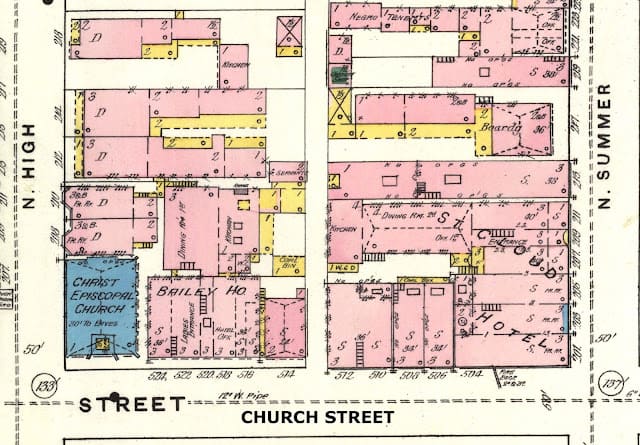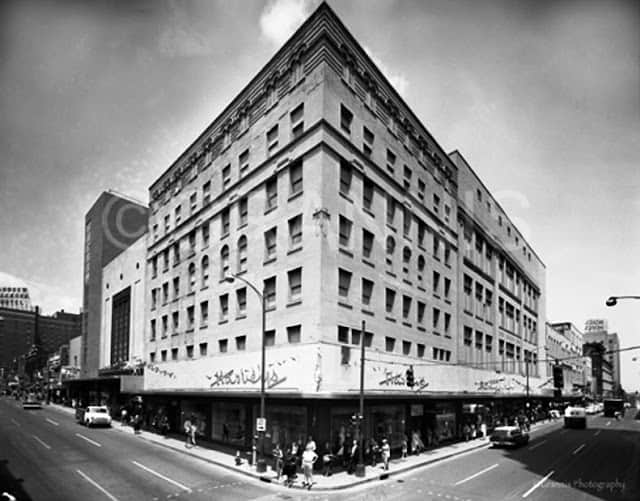Story as told by The Nashville History Blog
In the spring of 1982, James Wilcox made an offer on an old church at the corner of Church and High Street in Nashville, TN. In December he proudly took ownership of what was formerly the Christ Church. The old church stood next to Baily’s Hotel.
Roughly a year after the offer was made, construction of a seven story office building began with a retail space on the lower floor. The building was designed to have two elevators and a steam heat, a luxury at that time.
In December 1893, the owner’s name was chiseled into the stone over the arched entrance way. The name was mistakenly spelled Willcox, with two l’s, and was cut too deep to be corrected.

The Willcox Building opened in early 1894. Among the early tenants were the Berlitz School of Languages, a restaurant called The Tea Room, Fall’s Tennessee Business College, and the Royal Costume Company of New York.
In Mr. Wilcox offered office space, free of charge, to the committee in charge of planning Tennessee’s Centennial celebration.
In 1905 the Willcox building was sold to Major E. B. Stahlman, owner of the Banner newspaper in Nashville, for 105,000 dollars. Stahlman also purchased two residential lots that adjoined the Willcox building at the rear. He announced plans to enlarge the building for his newspaper. Stahlman sold the building at auction, three years later. Stahlman addressed the crowd, at the sale. He said he had decided against investing the thousands of dollars it would take to enlarge and convert the building, to make it suitable as a home for the Banner. The building fronting 60 feet on Church Street, ran back 80 feet along Sixth Avenue. In addition to the first floor and basement, it contained 83 offices. The high bidder, at 118, 600 dollars, was John H. Hitchcock, a Nashville business man. Within a short time the building began to be referred to as the Hitchcock building.
In 1911, the architectural firm of Marr and Holman were hired to design and remodel the space on the west side of the first floor for a new business. John Decker and Son (George Decker), had plans to open a confectionery sore and ice cream parlor in the space. Joe Holman and George Decker, traveled to other cities, searching for the latest ideas. The new store would be called, Decker’s. The store location, soon came to be known as, Decker’s Corner.The walls of the entire place will be wainscoted with Vermont white marble, with heavy green marble base, and above the marble will be mirrors with a cornice of Honduras mahogany. The ceiling and walls will be decorated with plaster relief ornaments and cornices, and this will be tinted and stenciled in appropriate colors. The floor will be of white tiling and the front entrance will be In the corner, giving access to both Church street and Sixth avenue. The front will be adorned with electrically lighted colored art glass with mahogany cornice and a green marble base. The show windows will have marble floors and will be so constructed as to prevent frosting in any kind of weather giving a view at all times to the public. – Nashville Tennessean and The Nashville America, March 26, 1911. The ice cream parlor, opened in July and was a success, with huge crowds on opening day. There were more details in a news article about the store. The color scheme was red and gold. The soda fountain counter top was of white onyx. Birch had been chosen for the woodwork.
Decker and Son also had a manufacturing business, at 1411 Church Street, where ice cream, candy and other goodies were made. By 1920, Decker and Son decided to concentrate on the ice cream business, and closed the ice cream parlor. They continued making ice cream at their plant at 1411 Church Street.
Liggett’s Rexall Drug Store moved into Decker’s space in 1921. By the 1920’s, the Hitchcock building had a number of doctors as tenants. Attorneys, dentists and other professionals also leased office space there. This would continue into the mid-1940’s. The building was updated in 1929, and renovated in 1936. Liggett’s store size was increased and remodeled The drug store would remain at 530 Church Street until 1945.
The building at 530 Church Street was half a century old when it was incorporated in the Harveys Department store, in 1946. No longer thought of as a separate business the Hitchcock name disappeared from Church Street. In 1953 Fred Harvey had workers remove and close in, the doors at the corner of Church and Sixth, and created a new entrance on Church Street, east of the corner.
Harveys occupied the Hitchcock building from 1946 until the downtown store closed in 1983.

In 1997, the old Lebeck building was torn down for a parking lot. The Hitchcock building stood alone for the first time in one hundred years, since the Lebeck building was constructed in 1906.
Today the building is known as Cornerstone Square. In 1992, Historic Nashville Inc. acquired a preservation facade easement for the building. This agreement, between the building owner and HNI, allows HNI to work with the owners, to protect the historical integrity of any part of the building facade, visible to the public.


